Seven Years Later: Can the World Finally Save the Rohingya?

On August 25, 2017, the world watched in horror as the Rohingya, a Muslim minority in Myanmar, faced unspeakable violence. The brutal military crackdown forced over 700,000 Rohingya to flee to Bangladesh, joining an additional 300,000 who had escaped earlier waves of persecution. This day is now remembered as Rohingya Genocide Remembrance Day, marking the culmination of decades of suffering and persecution that left villages razed and lives shattered. The overcrowded refugee camps in Cox’s Bazar stand as a grim reminder of the international community’s failure to protect the Rohingya.
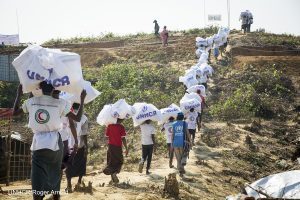
Life in Cox’s Bazar: A Struggle for Survival
Today, Cox’s Bazar now shelters over 984,000 Rohingya, including those who fled the violence in 2017 and earlier. All of them are cramped within just 26 square kilometers, leading to severe overcrowding. The living conditions are dire: access to clean water, sanitation, and healthcare is inadequate. The monsoon rains, which arrive with relentless force each year, only exacerbate these conditions, causing landslides and floods that further displace and damage what little the refugees possess. Thousands of shelters have been destroyed, pushing already vulnerable families into even more precarious situations.
The healthcare crisis in the camps is particularly alarming. The World Health Organization (WHO) has reported significant outbreaks of Hepatitis C and cholera, with a 38% positivity rate for Hepatitis C among those tested in 2024 alone. The lack of adequate healthcare infrastructure is a severe threat, especially to pregnant women and children, who are the most vulnerable in these harsh conditions.
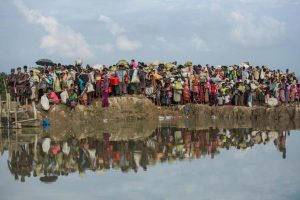
Bhasan Char Relocation: A Complex Initiative
To ease the overcrowding in Cox’s Bazar, the Bangladeshi government has relocated some refugees to Bhasan Char, a remote island in the Bay of Bengal. The move has been met with both praise for its intentions to improve living conditions and criticism for its execution, particularly concerning the island’s isolation and vulnerability to flooding. On the one hand, Bhasan Char offers better infrastructure, housing, and healthcare than the cramped conditions of Cox’s Bazar. On the other hand, the island’s isolation and susceptibility to flooding have raised serious concerns about the refugees’ freedom of movement and long-term viability.
As of 2024, approximately 30,000 Rohingya have been relocated to Bhasan Char, with more planned. However, human rights organizations have questioned the voluntariness of these relocations and the island’s suitability for permanent settlement. The relocation to Bhasan Char, while alleviating some pressure on Cox’s Bazar, underscores the complexity of the refugee situation—a situation where no solution seems ideal, and every choice comes with significant trade-offs.
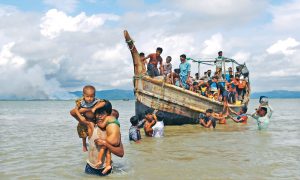
Repatriation: A Distant Dream
Repatriation to Myanmar, once seen as the most straightforward solution to the Rohingya crisis, now appears increasingly unlikely. Despite several attempts, not a single large-scale return has occurred since the exodus began in 2017. In 2018, about 3,450 refugees were identified for repatriation, but none returned, deterred by the lack of safety and guarantees from Myanmar’s government.
The Rohingya, stateless and stripped of rights, fear returning to a land where persecution has been their only inheritance. The military coup in 2021 only deepened the instability, turning Rakhine into a battlefield, with the Myanmar military, the Arakan Army, and ARSA locked in deadly conflict. Maungdaw and Buthidaung, once home to many Rohingya, are now war zones. The violence has even spilled over into Bangladesh, with significant disruptions in areas like Teknaf and Saint Martin’s Island. In April 2024, explosions and mortar shelling from across the border shook the island, creating widespread panic among residents. The situation escalated, prompting the suspension of ferry services, leaving both locals and refugees stranded.
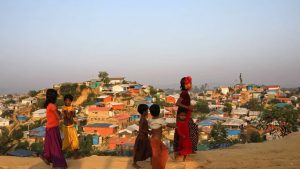
The Future of Rohingya Refugees: A Complex Path Forward
The interim government of Bangladesh, led by Chief Advisor Professor Muhammad Yunus, has expressed continued support for the Rohingya. The Yunus administration inherited the ongoing refugee crisis during a national transition period. The interim government is focused on balancing immediate humanitarian needs with the country’s long-term stability.
Internationally, the focus remains on finding a sustainable solution to the Rohingya crisis. However, the reality on the ground is that many Rohingya refugees in Bangladesh are slowly integrating into their host communities. This trend is not new; history has shown that displaced populations often find ways to assimilate into their new environments when faced with no choice. These Rohingya refugees, like many before them, are gradually becoming part of the social and economic fabric of Bangladesh and even beyond through economic migration to countries like Thailand and Malaysia.
Strengthening International Advocacy and Funding Efforts
The Bangladeshi government has been actively seeking international support to address the ongoing crisis. The 2024 Joint Response Plan, which aims to secure $852.4 million, highlights the urgent need for sustained international funding to support refugees and the host communities. Bangladesh can amplify its advocacy efforts to ensure these funds are secured, emphasizing the critical role of international aid in maintaining basic services like food, healthcare, and education for the refugees.
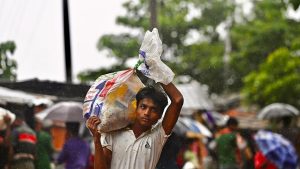
Addressing Emerging Security Threats
Recent reports indicate that the Rohingya face new threats as violence escalates in Myanmar’s Rakhine State. With ongoing conflicts between the Myanmar military and the Arakan Army, more Rohingya are attempting to flee to Bangladesh, exacerbating the existing humanitarian situation. Bangladesh can enhance border security while advocating for a ceasefire and safe zones within Myanmar to protect civilians.
Enhancing Local Integration Initiatives
While long-term repatriation remains uncertain, Bangladesh can explore more structured integration programs for the Rohingya within the country. This includes expanding vocational training and education programs to help refugees become self-reliant, reducing their dependence on international aid. Such initiatives also ease tensions between the refugee and host communities by creating opportunities for economic contributions from the Rohingya.
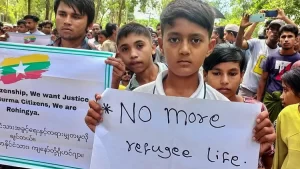
The Future of the Rohingya: Uncertain but Not Hopeless
As we reflect on the seventh anniversary of the Rohingya Genocide, it is clear that the crisis remains unresolved. The interim government of Bangladesh, under Chief Advisor Professor Muhammad Yunus., has expressed its commitment to supporting the Rohingya, but the challenges lie ahead. From securing international funding to addressing emerging security threats, the path forward requires a concerted effort from Bangladesh and the international community.
The Rohingya crisis is a stark reminder of the consequences of statelessness and the failure to protect vulnerable populations. Seven years have passed, and yet, the Rohingya continue to live in limbo, caught between a dangerous past and an uncertain future. The question remains: What will happen this time to the Rohingya? The answer depends on today’s actions and commitments to ensure their safety, dignity, and right to a secure future.
























